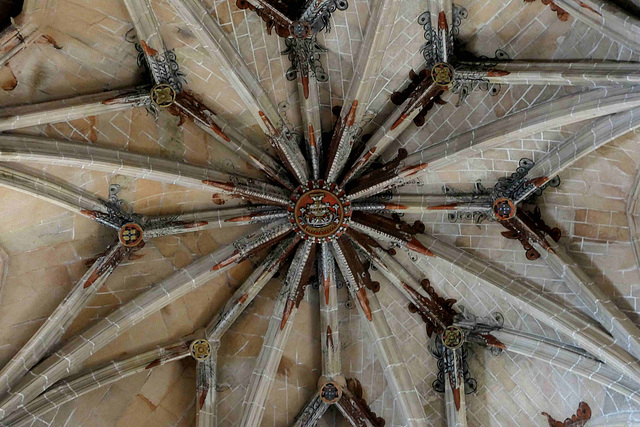Córdoba - Mezquita-Catedral
Sevilla - Real Alcázar de Sevilla
Lisboa - Mosteiro dos Jerónimos
Bragança - Igreja de Santa Maria
Winchester - Cathedral
Wells - Cathedral
Wells - Cathedral
Salisbury - Cathedral
Winchester - Cathedral
Valencia - Catedral de Santa María
Valencia - Lonja de la Seda
Úbeda - Sacra Capilla del Salvador
Baeza - Catedral de Baeza
Úbeda - Hospital de Santiago
cooling tower
Inside Bardo National Museum (Algiers)
Holy Trinity Cathedral, Sibiu
Inside Hagia Sophia in Istanbul
Gelati Monastery, interior
Icons inside Gelati Monstery (Georgia)
Sanatorium Metallurgist, Tsqaltubo, Georgia
Traditional village entrance (chorten gate) - Anna…
Burdamuseum Baden-Baden
Würthmuseum Dach
Alcobaca
Porto Konzerthalle ,Up or downstairs??
Manrique
VitraWendeltreppeOben
Decke an Wendeltreppe
RomPantheon3
Ceiling lighting - Bauhaus Dessau
Location
See also...
Keywords
Authorizations, license
-
Visible by: Everyone -
All rights reserved
-
22 visits
Sigüenza - Catedral de Santa María


Pliny the Elder mentions Segontia in the 1st century AD in his work "Naturalis Historia" as a Celtiberian settlement. The area was taken by the Romans in the Numantine War (154-133 BC). After the end of the Western Roman Empire, the city was conquered by the Visigoths, who also founded the diocese of Sigüenza in 589. Taken over by the Moors around 712, the Christians reconquered the city in 1123. The construction of the cathedral began only a short time later, but it would take several centuries to complete. Today Sigüenza is a town with a population of about 4500.
The Visigoths built a small castle in the 5th century above the town. The Moors built a large fortified castle in the early 8th century. It was enclosed by a defensive wall providing an area known as the medina. In 1124, the castle was retaken by Bernard of Agen allowing Simón Girón de Cisneros to build an episcopal palace there. In the 15th century, the castle was strengthened by the bishops to protect it from attacks from Aragon and Navarre.
Construction of the cathedral began in 1124 after the expulsion of the Moors and the appointment of Bernardo of Agen as bishop. It was built on foundations previously occupied by a Visigothic church and then a Moorish mosque. The construction of the church lasted until the 15th century and in the 16th century it received Gothic elements - especially in the interior - and additions in the Renaissance style.
The western facade is characterized by the robust towers in the medieval style of a church fortress. The portals on the south and west sides are preserved in the Romanesque style but with later Baroque and Classical additions. The cathedral, is composed of a Latin cross plant, with three naves, transept and a large apse, surrounded by the ambulatory. It is 80 meters long by 31 meters in width. The Gothic central nave is from the 14th century. The three naves are separated, by enormous pillars.
The Visigoths built a small castle in the 5th century above the town. The Moors built a large fortified castle in the early 8th century. It was enclosed by a defensive wall providing an area known as the medina. In 1124, the castle was retaken by Bernard of Agen allowing Simón Girón de Cisneros to build an episcopal palace there. In the 15th century, the castle was strengthened by the bishops to protect it from attacks from Aragon and Navarre.
Construction of the cathedral began in 1124 after the expulsion of the Moors and the appointment of Bernardo of Agen as bishop. It was built on foundations previously occupied by a Visigothic church and then a Moorish mosque. The construction of the church lasted until the 15th century and in the 16th century it received Gothic elements - especially in the interior - and additions in the Renaissance style.
The western facade is characterized by the robust towers in the medieval style of a church fortress. The portals on the south and west sides are preserved in the Romanesque style but with later Baroque and Classical additions. The cathedral, is composed of a Latin cross plant, with three naves, transept and a large apse, surrounded by the ambulatory. It is 80 meters long by 31 meters in width. The Gothic central nave is from the 14th century. The three naves are separated, by enormous pillars.
- Keyboard shortcuts:
Jump to top
RSS feed- Latest comments - Subscribe to the comment feeds of this photo
- ipernity © 2007-2024
- Help & Contact
|
Club news
|
About ipernity
|
History |
ipernity Club & Prices |
Guide of good conduct
Donate | Group guidelines | Privacy policy | Terms of use | Statutes | In memoria -
Facebook
Twitter

Sign-in to write a comment.